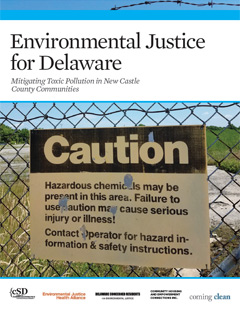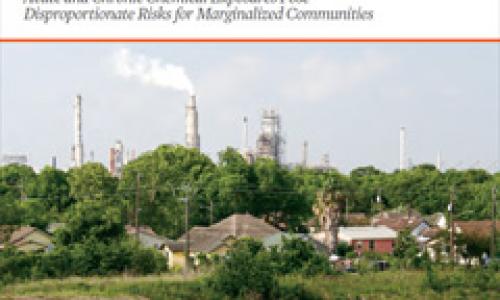As numerous studies have found, exposure to high levels of environmental pollution is one of the many risks faced disproportionately by people of color and people living in poverty. Blacks, Hispanics, and people living below or near poverty levels are significantly more likely to live near industrial facilities that use large quantities of toxic chemicals and pose risks of major chemical disasters.
The county of New Castle in northern Delaware is a case in point, according to a 2017 report, Environmental Justice for Delaware: Mitigating Toxic Pollution in New Castle County Communities, produced by a partnership between UCS, the Environmental Justice Health Alliance, Delaware Concerned Residents for Environmental Justice, Community Housing and Empowerment Connections Inc., and Coming Clean, Inc.
The report focuses on health and safety risks in seven communities—Belvedere, Cedar Heights, Dunleith, Marshallton, Newport, Oakmont, and Southbridge—located along an industrial corridor in the northern portion of New Castle County. All of these communities have higher poverty rates and most have higher percentages of people of color than Delaware statewide averages.
What the report found
Using publicly available data from the Environmental Protection Agency (EPA), the report quantifies the risks the seven study communities face in comparison with Greenville—a predominantly White, affluent community in the same area—and with the state of Delaware overall.
The analysis looks at potential cumulative impacts from four health and safety issues:
- risk of cancer and potential for respiratory illnesses affecting residents in the seven communities that stem from toxic outdoor air pollution;
- proximity to facilities in the EPA’s Risk Management Program (RMP) that use large quantities of toxic, flammable, or explosive chemicals and pose a high risk of a major chemical release or catastrophic incident;
- proximity to major polluting industrial sources that report their pollution emissions to the EPA Toxics Release Inventory (TRI); and
- proximity to contaminated hazardous waste sites listed in the EPA’s Brownfield and Superfund Programs.
The report found that these risks were substantially higher for residents of the study communities than for Greenville or Delaware overall.
The table below shows the report’s findings regarding cancer and respiratory risk:
The report found that the same chemicals were causing the largest health impacts across all the communities: formaldehyde and benzene, both well-known carcinogens, were the biggest cancer risk drivers, while acrolein—produced from the breakdown of burning gas and oil—contributed the majority of respiratory hazard.
Children are particularly vulnerable to the effects of toxic chemicals, as the report points out. Many schools in the seven study communities are close to chemical facilities or in other high-risk locations. In Southbridge, for example, seven schools with a total of more than 2,200 students are located in areas with substantially higher cancer risks and respiratory hazards than schools in the other communities studied.
Recommendations
To address these inequities, the report offers seven recommendations (for more detailed explanations, download the report PDF):
- Require chemical facilities to use safer chemicals and technologies.
- Ensure that facilities share information and their emergency response plans with nearby communities.
- Require large chemical facilities to continuously monitor and publicly report their fenceline-area emissions and health hazards.
- Prevent the construction of new or expanded chemical facilities near homes and schools and, conversely, prevent the siting of new homes and schools near dangerous chemical plants.
- Require that publicly accessible, comprehensive health impact assessments and mitigation plans be conducted to evaluate the cumulative impact of hazardous chemical exposures on nearby communities.
- Strengthen the enforcement of existing environmental and workplace health and safety regulations.
- Adopt and enforce strict motor vehicle emissions standards and limit heavy-duty truck traffic and idling in residential areas.






